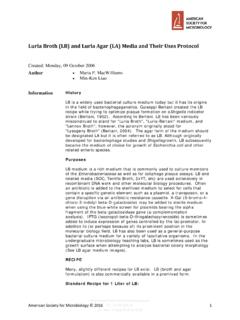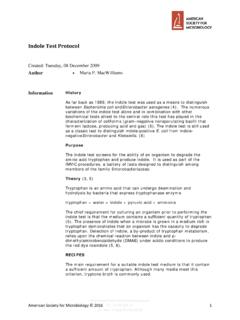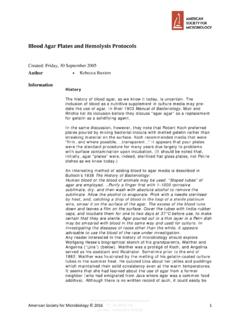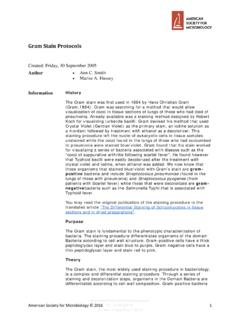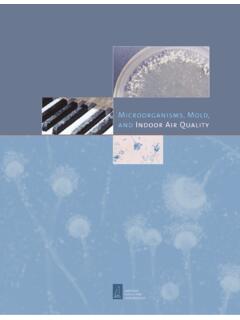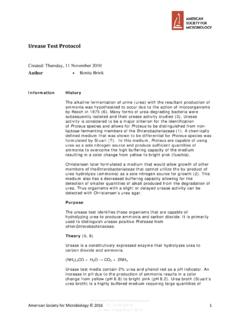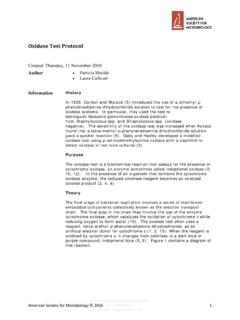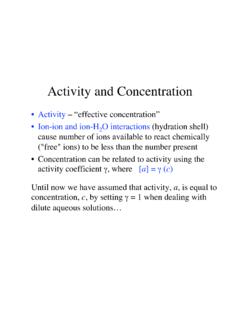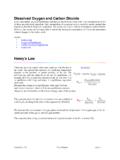Transcription of Kirby-Bauer Disk Diffusion Susceptibility Test Protocol
1 Downloaded from byIP: : Wed, 29 Aug 2018 12:55:47 American Society for Microbiology 2016 1 Kirby-Bauer disk Diffusion Susceptibility Test Protocol | | Created: Tuesday, 08 December 2009 Author Jan Hudzicki Information History The publication on penicillin by Alexander Fleming in 1928 is a milestone in the history of medicine. As more antimicrobial compounds were discovered, it was predicted that infectious diseases would be eliminated through the use of these antimicrobials (7). Unfortunately, the development of bacterial resistance to these antimicrobials quickly diminished this optimism and resulted in the need for physicians to request the microbiology lab to test a patient s pathogen against various concentrations of a given antimicrobial to determine Susceptibility or resistance to that drug.
2 The original method of determining Susceptibility to antimicrobials was based on broth dilution methods (5, 7), which although still the gold standard today, are time consuming to perform. This prompted the development of a disk Diffusion procedure for the determination of Susceptibility of bacteria to antimicrobials. By the early 1950s, most clinical microbiology laboratories in the United States had adopted the disk Diffusion method for determining Susceptibility of bacteria to antimicrobials. Each lab modified the procedure to suit its own needs, which included using different types of media, inoculum concentration, incubation time, incubation temperature, and concentration of the antimicrobial compound.
3 Interpretation of Susceptibility and resistance was based only on the presence or absence of a zone of inhibition surrounding the disk , and two or three different concentrations of the same antimicrobial were routinely tested against the pathogen (1). Many researchers published variations for the procedure resulting in multiple protocols that resulted in widespread confusion (1). In 1956, W. M. M. kirby and his colleagues at the University of Washington School of Medicine and the King County Hospital proposed a single disk method for antimicrobial Susceptibility testing (6). The lack of standardization for the determination of bacterial Susceptibility continued to be a problem throughout the early 1960s.
4 kirby and his colleague, A. W. bauer , extensively reviewed the Susceptibility testing literature. They consolidated and updated all the previous descriptions of the disk Diffusion method and published their findings (2). This publication led the World Health Organization to form a committee in 1961 to lay the groundwork for the development of a standardized procedure for single antimicrobial disk Susceptibility testing (7). The result was a standardized procedure for the disk Diffusion Downloaded from byIP: : Wed, 29 Aug 2018 12:55:47 American Society for Microbiology 2016 2 Susceptibility test, henceforth called the Kirby-Bauer disk Diffusion test (2). Currently, the Clinical Laboratory Standards Institute (CLSI) is responsible for updating and modifying the original procedure of kirby and bauer through a global consensus process.
5 This ensures uniformity of technique and reproducibility of results as pathogens develop new mechanisms of resistance and new antimicrobials are developed to fight these organisms. Interpretative guidelines for zone sizes are included in their publications (3). The CLSI publication, Performance Standards for Antimicrobial disk Susceptibility tests ; Approved Standard 9th Edition, represents the standard for clinical laboratories performing Susceptibility testing today. Purpose The purpose of the Kirby-Bauer disk Diffusion Susceptibility test is to determine the sensitivity or resistance of pathogenic aerobic and facultative anaerobic bacteria to various antimicrobial compounds in order to assist a physician in selecting treatment options for his or her patients.
6 The pathogenic organism is grown on Mueller-Hinton agar in the presence of various antimicrobial impregnated filter paper disks. The presence or absence of growth around the disks is an indirect measure of the ability of that compound to inhibit that organism. Theory Determination of bacterial resistance to antimicrobials is an important part of the management of infections in patients. The disk Diffusion method of kirby and bauer has been standardized and is a viable alternative to broth dilution methods for laboratories without the resources to utilize the newer automated methods for broth microdilution testing. When a 6-mm filter paper disk impregnated with a known concentration of an antimicrobial compound is placed on a Mueller-Hinton (MH) agar plate, immediately water is absorbed into the disk from the agar.
7 The antimicrobial begins to diffuse into the surrounding agar. The rate of Diffusion through the agar is not as rapid as the rate of extraction of the antimicrobial out of the disk , therefore the concentration of antimicrobial is highest closest to the disk and a logarithmic reduction in concentration occurs as the distance from the disk increases (7). The rate of Diffusion of the antimicrobial through the agar is dependent on the Diffusion and solubility properties of the drug in MH agar (2) and the molecular weight of the antimicrobial compound. Larger molecules will diffuse at a slower rate than lower molecular weight compounds. These factors, in combination, result in each antimicrobial having a unique breakpoint zone size indicating Susceptibility to that antimicrobial compound.
8 If the agar plate has been inoculated with a suspension of the pathogen to be tested prior to the placing of disks on the agar surface, simultaneous growth of the bacteria and Diffusion of the antimicrobial compounds occurs. Growth occurs in the presence of an antimicrobial Downloaded from byIP: : Wed, 29 Aug 2018 12:55:47 American Society for Microbiology 2016 3 compound when the bacteria reach a critical mass and can overpower the inhibitory effects of the antimicrobial compound. The estimated time of a bacterial suspension to reach critical mass is 4 to 10 hours for most commonly recovered pathogens, but is characteristic of each species, and influenced by the media and incubation temperature (7).
9 The size of the zone of inhibition of growth is influenced by the depth of the agar, since the antimicrobial diffuses in three dimensions, thus a shallow layer of agar will produce a larger zone of inhibition than a deeper layer. The point at which critical mass is reached is demonstrated by a sharply marginated circle of bacterial growth around the disk . The concentration of antimicrobial compound at this margin is called the critical concentration and is approximately equal to the minimum inhibitory concentration obtained in broth dilution Susceptibility tests . Zone size observed in a disk Diffusion test has no meaning in and of itself (7). The interpretation of resistance and Susceptibility to antimicrobials is determined through in vivo testing of blood and urine to calculate the obtainable level of a given antimicrobial that results in resolution of an infection.
10 This information is correlated with zone sizes resulting in the interpretive standards. The current interpretation standards can be found in the Clinical Laboratory Standards Institute Performance Standards for Antimicrobial disk Susceptibility tests : Approved Standards 9th Edition (3). RECIPE Sterile saline in 2-ml tubes McFarland standard Wickerham card Mueller-Hinton agar plates, 100 mm or 150 mm Caliper or ruler Antibiotic disksb Forceps Antibiotic disk dispenser (optional) 18- to 24-ho Vortex Sterile swabs Inoculating lo Bact-cinerato Alcohol pads 35 C to 37 C aRecommended organisms for quality assurance purposes are Staphylococcus aureus ATCC 25923 (Biosafety level (BSL) 2), Escherichia coli ATCC 25922 (BSL 1), and Pseudomonas aeruginosa ATCC 27853 (BSL 2) ( ), as the zone of inhibition for these organisms is known.

